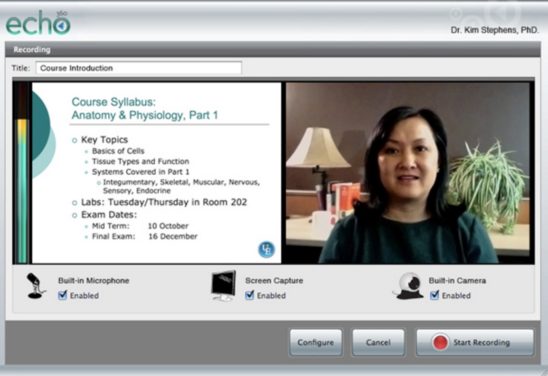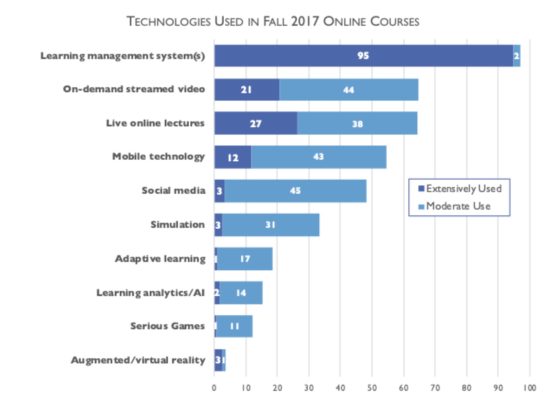The use of video
There is evidence from the two national surveys of online learning in Canadian post-secondary education that video is increasingly being used in both fully online and blended learning. The latest (2018) survey asked about the following uses of video:
- on-demand streamed videos (asynchronous)
- live online lectures/seminars (synchronous)
Almost all responding institutions use learning management systems either extensively (95%) or moderately (3%).
In comparison, live online lectures/seminars are moderately or extensively used by about two-thirds of institutions, as is on-demand streamed video (see Figure 1 below). These results are up slightly from the 2017 survey (62% using video).
Figure 1
(It should be remembered that these are institutional responses; individual use by faculty is not always tracked – compared with LMSs – so actual use may well be higher.)
It is perhaps not surprising that the figures for both synchronous and asynchronous use is almost identical, since live lectures can be recorded and streamed later.
Possible uses of video
At this point, I am moving away from hard data from the survey to discussing different pedagogical uses, drawing in some cases on examples from Contact North’s Pockets of Innovation.
Synchronous online sessions
This is where a faculty member basically does not change the classroom pedagogical model. There is in fact a wide variety of different models of delivery here, including:
- students are present in the room with the instructor where the lecture is presented as well as students studying remotely at home
- students are present in the room where the lecture is presented as well as groups of students studying at another campus or learning centre
- the lecturer is alone: at home, in the office, a video-conferencing room, studio, or lecture theatre; but all students are either at home individually (such as in many MOOCs) or with a group of other students at another centre.
- there are many other possible uses for synchronous video besides lectures. For instance video could be used for interactive, social games or for real-time project work in distributed groups.
The technology can also vary, depending on available bandwidth, from
- video out, video back (not recommended where there are more than half a dozen different transmission points/locations because of bandwidth issues)
- video out, audio back
- video out, text/chat back
The one thing all these methods have in common is that the student must be present at the same time that the lecture is delivered. The advantage is the active, realtime participation of learners in the form of synchronous questions and/or discussion. However, as we shall see, the dynamic of interaction between students, and between student and instructor, is likely to be different in each of these uses of synchronous sessions.
Asynchronous streamed sessions
However, if the synchronous lecture is recorded (as is now usual) students can also access the lecture asynchronously, usually by downloading the video through the LMS. The advantage of this to the student is that they have more flexibility of access; they do not have to be present at a set time, and can access the material as many times as needed. The disadvantage is that they cannot participate in real-time Q and A or discussion (although they can observe any such activities on the recording) unless they also watch the live presentation at the set time.
Asynchronous streamed learning resources
Although the national surveys did not directly investigate this, another use for asynchronous streamed video is for access to visual learning resources. These may be either open educational resources, located anywhere in the world, or video specifically developed for a particular course, such as animations, simulations, interviews, experiments, or demonstration of equipment (for more examples, see my open textbook, Chapter 7, Section 4).
The advantage of this use of video is that it is more likely to use the ‘affordances’ of the medium, using video in ways that would be difficult to do through other media such as talking or text. The disadvantage is that social learning (discussions, questions, etc.) has to be handled separately.
Integrating video and other media
Before there was synchronous video, there was asynchronous access to learning management systems. Students would have access to teaching materials mainly in the form of text or graphics, supplemented by asynchronous online discussion forums. Indeed, synchronous and asynchronous recorded lectures are increasingly being added to a standard, text-based courses as a supplement.
However, in many cases now, it is the other way round, with the video lectures the ‘core’ of the course, with the LMS providing access to additional reading material, storing the recorded lectures, and providing some asynchronous online discussion as follow-up to the lectures.
What’s the problem?
The main problem with synchronous video is that it’s business as usual: lectures one hour or more in length, being delivered to generally passive students. Access is somewhat improved, especially if recordings of the videos are also available, so what we have is what Ruben Puentedura calls augmentation: technology substituting for the lecture room thereby augmenting access, but no task redesign. The teaching remains, in Puentedura’s term, teacher-centric.
I have a lengthy critique of the lecture format in my book, Teaching in a Digital Age (Chapter 3, Section 3) but my main criticisms of synchronous use of video are four-fold:
- content delivery and comprehension is emphasised at the expense of higher-level skills development
- students learn less when they are not interacting with the instructor, each other and the learning materials
- the affordances of video (its unique pedagogical characteristics) are not being effectively exploited
- what we have learned about effective online learning design from asynchronous online teaching is not being applied to synchronous teaching.
There are also related issues. It is common for instructors to report difficulties when there are students present with the instructor, but also students at remote sites. These remote students often feel ‘second-class’ and it requires re-designing the presentation to ensure that remote students are equally engaged. It is often better if everyone (including the lecturer) is remote, as that enables ‘perceived’ equal access to all students.
The other big problem is that instructors are often very satisfied with their face-to-face teaching and see no reason to change when they go online. Indeed, it is the facility to continue doing what they have been doing in the classroom that makes synchronous video so attractive to them.
Lessons from the research
There is now a great deal of research on video lecturing, such as the work of Richard Mayer, very simple but essential information such as the optimum length of an uninterrupted presentation (around 15 minutes) before students lose concentration and attention (see UBC’s excellent ‘Design principles for multimedia‘ for more on the research behind this).
I have suggested in an earlier blog post: Why not just record my lectures? my own views on how to improve the use of video in online learning – essentially the need to re-design for the online learning environment.
The main issue here though is that online learning can not only increase access but improve the quality of the teaching by offering alternative and perhaps more essential learning outcomes, such as intuitive thinking, critical thinking and independent learning. Just moving lectures online will not do this.
What is clear – surprise, surprise – is that we need more research on the effectiveness of these different approaches to teaching, in terms of the conditions needed for certain methods to succeed, and appropriate criteria for assessing learning effectiveness not necessarily based on traditional classroom teaching.
Over to you
Are you seeing video lectures replacing specifically designed asynchronous learning for online delivery?
Is this a good thing, in that it is encouraging instructors to teach online who would not otherwise do so?
Are you seeing any differences in outcomes as a result? Are students learning more or less of the same, or are they learning something different?
Is synchronous discussion inherently superior to asynchronous discussion? Is spoken discussion better than written discussion?
Where’s the research on this? Or don’t we need it?
I look forward to your comments on this.











 Dr. Tony Bates is the author of eleven books in the field of online learning and distance education. He has provided consulting services specializing in training in the planning and management of online learning and distance education, working with over 40 organizations in 25 countries. Tony is a Research Associate with Contact North | Contact Nord, Ontario’s Distance Education & Training Network.
Dr. Tony Bates is the author of eleven books in the field of online learning and distance education. He has provided consulting services specializing in training in the planning and management of online learning and distance education, working with over 40 organizations in 25 countries. Tony is a Research Associate with Contact North | Contact Nord, Ontario’s Distance Education & Training Network.


Thank you for raising this important issue. Agree that it is a shame that there is so little research to guide practice in this area, despite the widespread use of videos in online education. In a related issue, we have just submitted for publication the results of a natural experiment that shows no difference in outcome between Open Online Courses offered with and without tutor moderation of discussion forums.
That’s really interesting Richard – about the lack of difference in outcomes. Was there any difference in the student experience of learning between courses with and without tutor moderation?
Tony, I have come to your blog at a very timely moment in my work. I have taught online for over 10 years and on campus for 20 and am trying to encourage my current colleagues to rethink their practice in regards to online lectures, or rather their practice of recording live lectures and uploading them to the LMS for online (and on campus) students. My view – admittedly, based on experience rather than empirical research – is that this is a poor way of teaching, for the reason you mentioned (no transformation of teaching and learning, just augmentation) and it’s ultimately unsatisfying for both cohorts of student.
I encourage my colleagues to consider recording provocations rather than lectures – shorter videos that raise issues and multiple perspectives and ideas and challenges and cases and applications as well as presenting information. You post has encouraged me to continue this encouragement rather than to give in to the orthodoxy. Thanks.
Wait! Tony… What about video in the hands of students! Recording video as they practice skills and create. We’ve built WeVu.video here at UBC for this. There are also products like GoReact, Canvas Arc Video, and Bongo that are built for this.
Of course, I agree completely that video currently perpetuates a content-delivery model and basically replicates a pedagogy we all want to bury once and for all. In fact, a lot of the EdTech industry is like this, as I argue in something I wrote last year: https://medium.com/@mosscutlers/edtechs-content-bias-8cf24a56e162.
Please, everyone, check out our WeVu website. “A Different Video Platform”. As we say: “WeVu turns educational video upside down!”. This is the future of video in education. Please share it; it’s so hard to get the word out about new technologies that are grounded in modern pedagogy.
Looking forward to hearing your keynote tomorrow at CNIE in Vancouver, hosted by the Faculty of Arts at UBC, where WeVu was built from scratch!
Completely agree, Fred – getting students to use video is a great way for them not only to learn but also demonstrate their learning, from student teachers recording their teaching practice and self-critiquing it to business students developing two minute video ‘elevator’ pitches for their business idea. And as you say in the article video can be tremendously useful for skills development – as can VR. I recommend to all my readers to take a look at WeVu – a much alternative than the LMS!